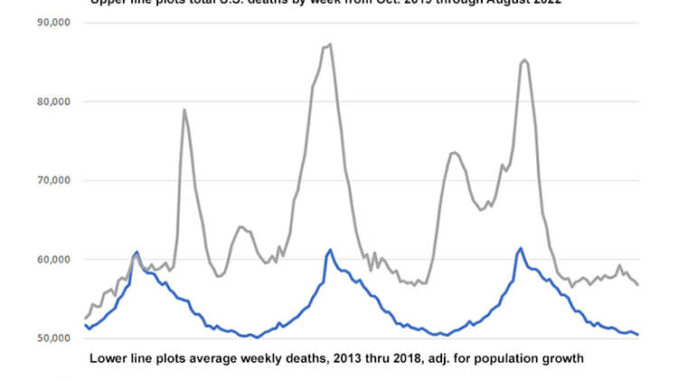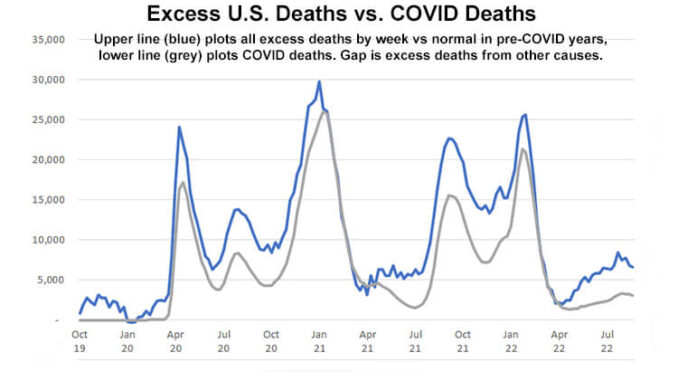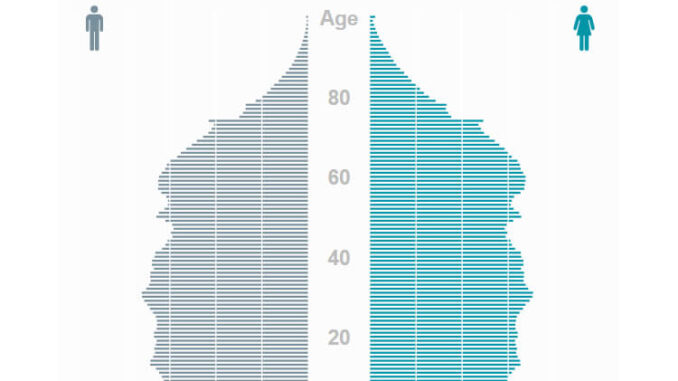There are a half-million excess deaths in the United States that are unaccounted for—and the usual suspects do not add up to that many.
By a significant margin, and according to data reported weekly by the U.S. Centers for Disease Control, the death rate in America remains elevated. If nothing else is certain as Americans continue to cope with the most disruptive event in the last half-century, one fact is indisputable: As the number of cases of COVID-19 decreased over the past few months, they now account for less than half of this persistently elevated death rate.
In the six years before the COVID era, deaths in the United States averaged between 2.6 million and 2.8 million people per year. These averages are adjusted for population growth, and with a population as large as that of the United States, the numbers should be, and are, remarkably stable. During the three years immediately preceding 2020, for example, the population growth-adjusted death rate from all causes varied by only 1.5 percent.
None of that is true today. The increase in total deaths—deaths from all causes, not just COVID deaths—is up significantly. In the nine months in 2020 from April to December, a normal death count would have been 2.04 million. Instead, during that period, 2.57 million people died, 26 percent above normal.

Deaths in the United States from all causes in 2021 were also well above normal—3.46 million versus only 2.8 million if it had been a normal year, 24 percent over normal. So far in 2022, with complete data available through August, total deaths were 1.91 million, against a projected 2.21 million if it were a normal year, which is still up 16 percent. These numbers are shown graphically on the chart below.<
>
To put these overages in perspective, in recent decades before COVID came along, a very bad flu season would mean an increase in total deaths, but typically not much more than the usual increases every flu season. This can be seen above, where the normal multi-year average (blue line) rises to a peak of around 60,000 total deaths per week during the worst month of flu season in January, then descends to around 50,000 per week in mid-summer. Even the H1N1 virus didn’t have a significant overall impact. Between 2009 and 2010, the CDC estimates around 12,500 Americans died from H1N1. That represents not quite a 0.5 percent increase in total deaths.
While it is encouraging that total excess deaths in the United States during 2022 so far are only up 16 percent compared to 24 percent in 2021 and 26 percent in the last nine months of 2020, they are still well above anything we have seen in the United States in the last 100 years. But more troubling is the fact that according to the CDC’s own data, most of these excess deaths cannot be attributed to COVID. In the chart below, the blue line plots the number of excess deaths over the past two-and-a-half years, and the gray line plots how many of those excess deaths are attributable to COVID. The gray line is consistently below the blue line.

Breaking this down to numbers reveals the following percentages of unexplained excess deaths. During the first nine months of the pandemic through December 2020, 32 percent of excess deaths were not reported as COVID deaths. During 2022, 29 percent of excess deaths were not reported as COVID deaths, and through the first eight months of 2022, 32 percent of excess deaths are unexplained by COVID. The most recent data are not encouraging. For the two most recent months for which we have complete data from the CDC—July and August—57 percent of excess deaths are not explained by COVID.
These numbers cannot be dismissed. The sample sizes are too big. In July and August, 26,685 people were reported dead from COVID. But during those same two months, 62,576 more people died than should have died in a normal July and August. What can account for this?
Overall, since the COVID-19 pandemic began, from April 2020 through August 2022, the CDC reported 1,044,323 COVID-related deaths. But so-called excess deaths during that period, even when adjusting for population growth, are 1.5 million. There are a half-million excess deaths in the United States that are unaccounted for. The usual suspects do not add up to that many.
For example, suicides increased from 45,979 in 2020 to 47,646 in 2021. But there were 48,344 suicides reported in 2018, two years before the pandemic. Murders were up 30 percent in 2020 versus 2019, then up by another 6 percent in 2021. These are alarming trends. But they only account for about 7,000 excess homicides over pre-COVID averages. Deaths from drug overdoses are way up, over 22,000 more in 2021 compared to 2020, with 2020 drug overdoses up about 8,000 over 2019. Automobile fatalities were up by 4,000 in 2021 compared to 2020. All of this is alarming, but numerically they do not explain what we’re seeing.
Deaths from suicides, murders, drug overdoses, and automobile fatalities—all combined and over the past two-and-a-half years—may account for as many as 100,000 of the 500,000 unexplained excess deaths in the United States, and that’s being generous.
What has killed the other 400,000 Americans during the COVID era, since we know it wasn’t COVID?
One suggestion, easily debunked, is that we have an aging population. It’s true our population is aging, but this still doesn’t explain the excess deaths. If you view what is known as a “population pyramid” for the United States as of 2021 (shown below), at the top you will see that America’s senior citizens, plotted by age, form a fairly smooth downward slope. But there is a blip on the slope, seen for men and women aged 75, i.e., born in 1946 in the first wave of the Baby Boom. How significant is this bulge in the slope, since people born in that year are nearing the end of the average life expectancy?

As it is, among Americans still living, about 890,000 more were born in 1946 than were born in 1945. It’s possible because people born immediately after World War II are just now beginning to pass through the years when they are most likely to die of natural causes, we will see higher overall death rates than we have seen in the years 2013 through 2019, a period during which death rates in the United States were stable from year to year. But wouldn’t COVID have finished them off, even if people approaching the ends of their lifespans are more numerous than usual?
America’s current age demographics may explain a small and temporary increase in the death rate in America today. But since only a small percentage of Americans actually die in the year corresponding to the average lifespan for their birth-year cohort, it is not a significant factor contributing to excess non-COVID deaths.
Other possible causes of excess deaths in the United States have been explored elsewhere and remain difficult to quantify. Clearly, there are increased incidents of disease fatalities that are the result of deferred diagnosis and deferred treatment during the pandemic. But even with access to complete data, any honest assessment would have to acknowledge many subjective assumptions and present a wide range of possible answers.
The elephant in the room, of course, is the new vaccines and to what extent excess deaths can be attributed to adverse events caused by hundreds of millions of Americans receiving multiple COVID shots. Data from the VAERS website (Vaccine Adverse Event Reporting System) do not indicate nearly enough fatalities from the COVID shot to begin to explain a half-million non-COVID disease deaths in the past two years, but those numbers are widely disputed.
Without diving into that rabbit hole, it is sufficient to say excess deaths in the United States that aren’t caused by COVID might be primarily the sum of increases in suicides, murders, car accidents, drug overdoses, a disproportionately large number of 1946 babies reaching the limit of their life expectancy, and deferred diagnoses and deferred treatments. Or it might be something else.
Regardless of why, the percentage of excess deaths that remain unexplained by COVID has doubled in the past few months and now accounts for two out of three excess deaths. This bears close watching as life in the time of COVID goes on, and on, and on.
<
>
<
>



Leave a Reply
You must be logged in to post a comment.